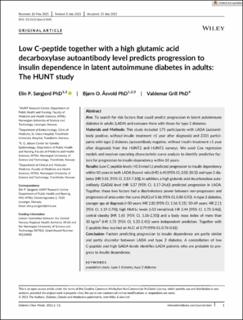| dc.description.abstract | Aim: To search for risk factors that could predict progression in latent autoimmune diabetes in adults (LADA) and compare them with those for type 2 diabetes. Materials and Methods: This study included 175 participants with LADA (autoanti-body positive, without insulin treatment ≥1 year after diagnosis) and 2331 partici-pants with type 2 diabetes (autoantibody negative, without insulin treatment ≥1 yearafter diagnosis) from the HUNT2 and HUNT3 surveys. We used Cox regressionmodels and receiver operating characteristic curve analysis to identify predictive fac-tors for progression to insulin dependency within 10 years. Results: Low C-peptide levels (<0.3 nmol/L) predicted progression to insulin dependency within 10 years in both LADA (hazard ratio [HR] 6.40 [95% CI, 2.02-20.3]) and type 2 diabetes (HR 5.01 [95% CI, 3.53-7.10]). In addition, a high glutamic acid decarboxylase auto-antibody (GADA) level (HR 5.37 [95% CI, 1.17-24.6]) predicted progression in LADA. Together, these two factors had a discriminatory power between non-progressors and progressors of area under the curve (AUC) of 0.86 (95% CI, 0.80-0.93). In type 2 diabetes, younger age at diagnosis (<50 years: HR 2.83 [95% CI, 1.56-5.15]; 50-69 years: HR 2.11[95% CI, 1.19-3.74]), high HbA1c levels (≥53 mmol/mol, HR 2.44 [95% CI, 1.72-3.46]),central obesity (HR 1.65 [95% CI, 1.06-2.55]) and a body mass index of more than30 kg/m2(HR 1.73 [95% CI, 1.23-2.41]) were independent predictors. Together with C-peptide they reached an AUC of 0.79 (95% CI, 0.76-0.82).Conclusion: Factors predicting progression to insulin dependence are partly similarand partly dissimilar between LADA and type 2 diabetes. A constellation of low C-peptide and high GADA levels identifies LADA patients who are probable to pro-gress to insulin dependence. | en_US |

